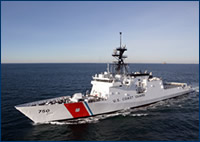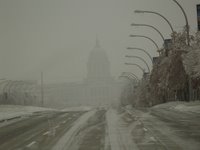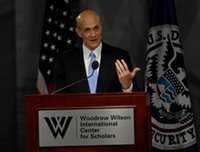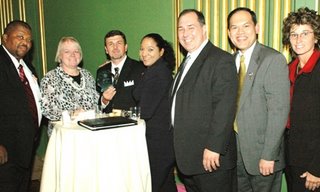A Trip to the Border
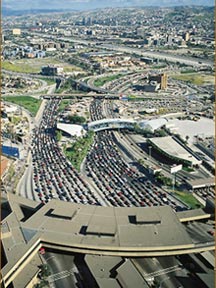 In San Diego I visited the port of San Ysidro, the largest port in the country on one of the busiest days of the year. Observing our defense in depth I witnessed canine teams in action walking the inbound lanes and officers interviewing people. I met with the Border Patrol and inspected the double fencing we have in the San Diego area and was briefed on the violence that criminals trying to get into this country carry out at the border. This does not get a lot of press coverage in the Washington DC area, but make no mistake about it, this is a combat zone at the border and our men and women deal with an enemy who uses coordinated command and control, modern communications technology and distributed approaches with violence to enter this country illegally. I had the opportunity to visit “Smugglers Gulch” around sunset and saw people across the border assembling at various staging areas for what would most likely be an attempt to cross at night. I also saw first hand where secure borders that protect our citizens in this country can lead to strong economic development that benefits business and individuals.
In San Diego I visited the port of San Ysidro, the largest port in the country on one of the busiest days of the year. Observing our defense in depth I witnessed canine teams in action walking the inbound lanes and officers interviewing people. I met with the Border Patrol and inspected the double fencing we have in the San Diego area and was briefed on the violence that criminals trying to get into this country carry out at the border. This does not get a lot of press coverage in the Washington DC area, but make no mistake about it, this is a combat zone at the border and our men and women deal with an enemy who uses coordinated command and control, modern communications technology and distributed approaches with violence to enter this country illegally. I had the opportunity to visit “Smugglers Gulch” around sunset and saw people across the border assembling at various staging areas for what would most likely be an attempt to cross at night. I also saw first hand where secure borders that protect our citizens in this country can lead to strong economic development that benefits business and individuals.I visited the Port of Long Beach, CA and observed large cargo ships being unloaded and observed our screening operations using X-rays, remote portal monitors and the new Advanced Spectroscopic Portal (ASP). This is a business where profit margin to the port operators is low, time is money and time is measured in seconds and minutes. I was briefed on how the Director of Port Operations and the USCG Captain of the Port meet every morning to coordinate their operations. This serves as a multiplier in the use of their resources.
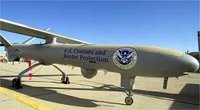 Traveling to Arizona, I met with the Custom and Border Protection (CBP) folks who run air operations and received a detailed briefing on the use of Unmanned Aircraft Systems (UAS) and the significant role they play in securing our borders. The Predator B UAS has the capability to fly for 30 hours at a time covering up to 2,800 nautical miles at altitudes over 50,000 ft mean sea level carrying a 3,500 pound payload. During 2006 and 2007 CBP Predator Bs flew more than 1500 flight hours in support of border security missions and contributed to the seizure of more than 15,000 pounds of marijuana and the apprehension of more than 4,000 illegal aliens.
Traveling to Arizona, I met with the Custom and Border Protection (CBP) folks who run air operations and received a detailed briefing on the use of Unmanned Aircraft Systems (UAS) and the significant role they play in securing our borders. The Predator B UAS has the capability to fly for 30 hours at a time covering up to 2,800 nautical miles at altitudes over 50,000 ft mean sea level carrying a 3,500 pound payload. During 2006 and 2007 CBP Predator Bs flew more than 1500 flight hours in support of border security missions and contributed to the seizure of more than 15,000 pounds of marijuana and the apprehension of more than 4,000 illegal aliens.Flying by helo to the Law Enforcement Center I observed the different types of terrain at the border, some very harsh, and saw first hand why an integrated architecture that utilizes a combination of fences, technology and manpower and not one of these alone, is required to secure the border.
The Tohono O’odham Indian Nation occupies a substantial portion of the Arizona land area and our relationships with this sovereign nation are a key element of our outreach in the state. I had the good opportunity to meet with representatives of the nation and understand how the Border Patrol and the nation cooperate in matters concerning security of the border.
Also during my visit I had the opportunity to observe first hand how our deployed biometric and biographic systems are aiding our Border Patrol agents. I observed agents identify an illegal alien that was caught – his seventh time trying to enter the country, and another illegal alien with many documented criminal warrants was apprehended.
On the ground I observed some of the various technologies that are being deployed as part of SBInet and spoke directly with the people doing operational testing of the P-28 system. When fully matured this type of capability will greatly enhance our border operations.
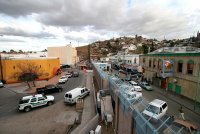 In Nogales, Ariz., the nation’s largest agricultural port, I learned about the complexities of controlling agricultural products and the tremendous job that our agricultural inspectors do. I saw how the inspectors approach the difficult task of trying to locate banned products, as well as the magnitude of the large number of commodities they look for. Most of the folks I met have biology or science degrees and have been working a range of jobs that employ this expertise. I also observed how technology is speeding the flow of traffic while still providing the assurance that we need. On one of the busiest days of the year I watched how visitors to our country are treated with respect and dignity while our people on the front line are enforcing our laws.
In Nogales, Ariz., the nation’s largest agricultural port, I learned about the complexities of controlling agricultural products and the tremendous job that our agricultural inspectors do. I saw how the inspectors approach the difficult task of trying to locate banned products, as well as the magnitude of the large number of commodities they look for. Most of the folks I met have biology or science degrees and have been working a range of jobs that employ this expertise. I also observed how technology is speeding the flow of traffic while still providing the assurance that we need. On one of the busiest days of the year I watched how visitors to our country are treated with respect and dignity while our people on the front line are enforcing our laws.The challenge to our men and women on the front line is the myriad of documentation that they must scrutinize for 45-60 seconds to make a decision on whether or not to admit someone to this country. This is a very difficult challenge especially when you examine the large number of documents that people on the front line have to deal with. It puts into clear perspective why we are driving to implement many of our programs such as the Western Hemisphere Travel Initiative.
There has been violence in Nogales and until you visually eyeball the geography and realize it is a city with a wall through it – one side in the US and the other side in Mexico, do you get a good appreciation for how difficult this challenge is.
The greatest opportunity I had during this trip was to get to know many of our people. The people that work on the border come from a range of diversified backgrounds with ages that range from the early 20s to the 50s and higher. But perhaps what was very inspiring to me was that they all approach their work with enthusiasm, dedication and a sense of commitment that is probably without peer. We are all very fortunate that these dedicated men and women are on the front lines every day serving our nation.
Paul A. Schneider
Deputy Secretary (Acting)
Labels: biometrics, border security

